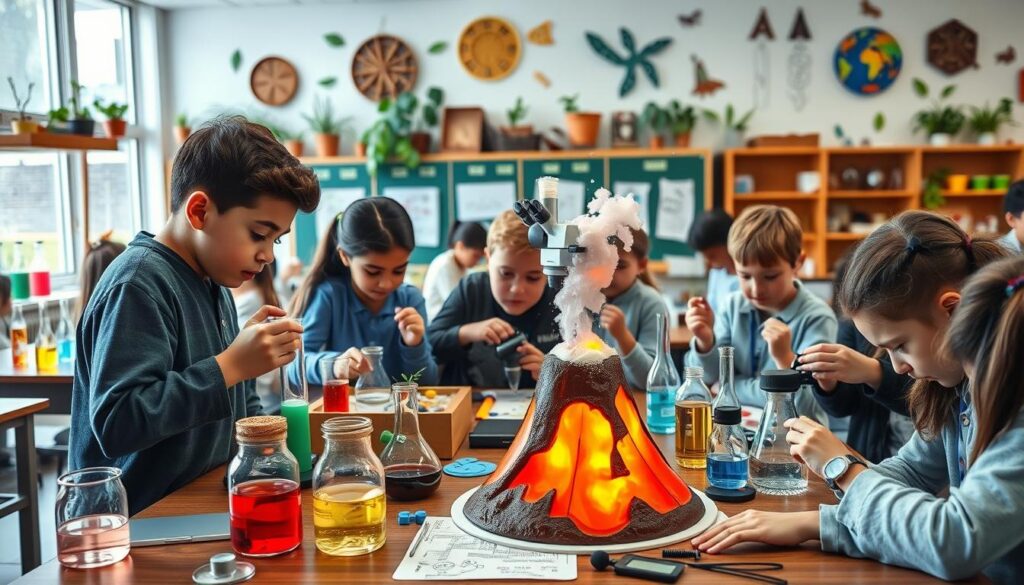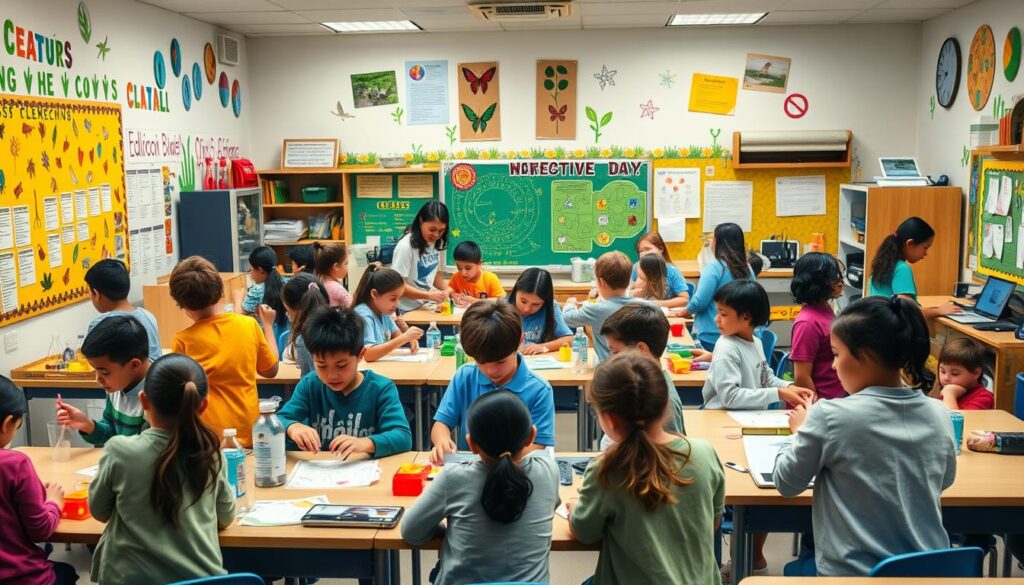Table of Contents
Did you know that over 150 free science experiments are available to engage students? These experiments help students understand scientific concepts better. As an educator, I’ve found that using effective teaching strategies in science is key. It helps students love STEM education more.
Effective teaching strategies in science do more than just teach content. They create exciting learning experiences. These experiences help students think critically, solve problems, and understand the world better. By using techniques like inquiry-based learning, hands-on activities, differentiated instruction, and technology integration, we can make science lessons more engaging.
Key Takeaways
- Effective teaching strategies in science are essential for enhancing student engagement and learning outcomes.
- Incorporating a range of best practices, such as student talk, high-interest motivators, and inquiry-based learning, can create dynamic and effective science lessons.
- Hands-on activities and project-based learning are crucial for fostering critical thinking, scientific reasoning, and a deep understanding of scientific concepts.
- Differentiating instruction and integrating technology can cater to diverse learning styles and promote collaborative learning in the science classroom.
- Formative assessment and real-world connections are key to ensuring students develop a lasting understanding of science and its relevance to their lives.
The Effectiveness of Student Talk in Science Learning
The best way to teach science is through student talk. Studies show that when students discuss science, they learn a lot. This method fits the science of learning well. It uses important learning techniques like making things clear, recalling information, and getting feedback.
Versatility of Student Talk
Student talk works in many ways, like summarizing, think-pair-share, and Jigsaws. It helps students share their thoughts and understand science better. Teachers use it to make students think deeply about science.
Engaging Students Through Talk
When students talk and think together, they learn more about science. This method improves their student talk skills. It also makes them love learning and science more.
Motivating Students with High-Interest Strategies
Teaching science is more than just sharing facts. It’s about sparking curiosity and motivation in students. Using high-interest motivators is a great way to grab their attention and make them excited about what’s coming.
Using Physical Objects as Motivators
Physical objects, specimens, and hands-on demos are great for catching students’ interest. Starting a lesson with a fascinating science object can spark conversations and improve observation skills. It’s especially good for younger students and works well with many science topics.
Engaging with Visual and Auditory Stimuli
Visual aids like images, videos, and multimedia presentations also motivate students. They grab attention and meet different learning styles, combining sight and sound. By offering a mix of sensory experiences, teachers can create a learning space that inspires and engages students.
The secret to motivating science students is to tap into their curiosity. Make the content interesting, relevant, and easy to understand. By using strategies that appeal to their senses and what they already know, teachers can build a love for scientific discovery.
Inquiry-Based Learning: A Student-Centered Approach
Inquiry-based learning is a great way to teach science to all kinds of students. It makes students the main focus, letting them dive into science by observing, classifying, and predicting. They also get to share their findings and explain science concepts in their own words.
This method naturally helps students of different language skills. It’s a way to make science learning fun and inclusive. Students get to explore and share their ideas, which boosts their curiosity and problem-solving skills.
Studies show that inquiry-based learning meets the Next Generation Science Standards (NGSS) well. Yet, some teachers might find it hard to switch to this method. It’s important to see the value in letting students explore science freely. This way, both teachers and students can learn deeply and enjoy the process.
Using inquiry-based learning in science class can change the game for everyone. It lets students be more involved in their learning. This helps them develop scientific practices and language skills. It makes science class more fun and welcoming for everyone.
Hands-On Activities: Fostering Scientific Practices
Hands-on learning is key in science classes. It lets students dive into science, solve problems, and use the scientific method. Activities like growing plants, testing floating objects, or creating their own experiments make science real and interesting.
Structured Hands-On Activities
Structured activities give students clear steps to follow. They help students learn important scientific practices like experimentation and critical thinking. By doing these activities, students can see, collect data, and make conclusions, which helps them understand science better.
Open-Ended Explorations
- Open-ended hands-on learning activities make students think like scientists.
- They design and test their own projects, improving their scientific practices and critical thinking.
- These activities encourage discovery and real science exploration, making science more engaging.
Both structured and open-ended hands-on activities are great for learning science. They help students grasp scientific concepts and the scientific process. Through these activities, students develop important scientific practices and appreciate the problem-solving and critical thinking in science.

effective teaching strategies in science
Two key strategies in science teaching are project-based learning and station-based rotations. These methods keep students engaged and build important skills for science and problem-solving.
Project-Based Learning
Project-based learning lets students dive deep into scientific topics. It helps them develop research, problem-solving, and communication skills. They end their learning with a presentation or product that shows what they’ve learned.
Station-Based Rotations
Station-based rotations let students try different hands-on activities and materials. This method encourages teamwork, critical thinking, and applying science in fun ways.
Using project-based learning and station-based rotations, teachers can make science exciting. They help students develop skills like problem-solving, critical thinking, and real-world connections. These methods make learning fun and interactive, helping students understand science better.
Peer-Led Team Learning: Empowering Student Leaders
Peer-led team learning (PLTL) is a new way to teach that uses student leadership and teamwork. It works well in schools for kids and in colleges too. It pairs smart students with those who need help, creating a place where everyone learns together.
Research shows PLTL works great. Students in PLTL classes do better on exams and feel more confident. They also do well in their classes overall. This is because they learn from each other and get better at leading and talking.
PLTL groups have 4-7 students. They must all participate. Classes that are small, like Biology 1113.02, help everyone get to know each other better.
PLTL really helps students who are not often seen in science classes. It keeps them in school, helps them catch up, and makes them think better. It also makes them feel like they belong.
More and more classes are using PLTL. Now, even classes like General Biology I and Introduction to Financial Accounting use it. Students say they like working with their friends, practicing more, and understanding the lessons better.
The Peer-Led Team Learning Leadership Program is for first-year students who are minorities in STEM. It shows the university’s dedication to peer-led learning, collaborative learning, and student leadership. It helps students become leaders and help their friends, making learning more fun and open.
As we need more people in STEM jobs, PLTL is key. It helps students who are not often seen in science to get involved. By using peer-led learning and mentorship, teachers can make sure all students do well and reach their goals.
Flipped Learning: Maximizing Classroom Time
Flipped learning is a smart way to use classroom time. Students watch videos, read, or listen to podcasts at home. This lets them dive into discussions and hands-on activities in class.
Preparing Students for Flipped Learning
Teachers need to get students ready for flipped learning. They should explain what to expect and offer help for learning on their own. This way, class discussions can be more in-depth and meaningful.
Facilitating Deeper Discussions
Flipped learning lets teachers lead deeper talks and more student-centered instruction in class. By moving content outside class, teachers can help with independent learning. They also encourage classroom discussions that help students understand better.
Research in science education backs up the flipped classroom’s benefits (Deslauriers & Wiemen, 2011; McLaughlin et al., 2013; Missildine, Fountain, Summers, & Gosselin, 2013; Papadopoulos & Roman, 2010; Strayer, 2012; Warter & Dong, 2012). As educators keep exploring flipped learning in science, the chance for better student-centered instruction and flipped learning looks promising (Bergmann, Overmyer, & Wille, 2013; Bergmann & Sams, 2012; Brunsell & Horejsi, 2011, 2013).
Differentiation: Catering to Diverse Learners
In the dynamic science classroom, differentiated instruction is key. It engages students of all abilities and learning styles. Teachers tailor learning experiences to meet each student’s unique needs. This creates an inclusive environment where everyone can succeed.
At the core of differentiated instruction is the understanding that students learn differently. Some do well with hands-on activities, while others prefer visual or auditory learning. Personalized learning approaches, like scaffolding and flexible assignments, help challenge and support each student.
Differentiation also boosts student engagement through interactive experiences and student-led tasks. When students take charge of their learning, they feel more invested in the scientific process.
- Offering a variety of learning activities meets the diverse needs and preferences of students.
- Scaffolding and differentiated support help all learners access and engage with the content, whether they need a little help or a lot.
- Encouraging student-led tasks and peer-to-peer learning empowers students to be independent and understand the material better.
By adopting differentiated instruction and inclusive education, teachers can make science classrooms vibrant and engaging. Here, every student can thrive and find their passion for science.

Conclusion
Effective teaching strategies in science are key for engaging students and deepening their understanding. They help prepare students for STEM fields. By using student talk, hands-on activities, and project-based learning, teachers can make science lessons exciting. This approach encourages critical thinking and a love for science.
Teachers can make a big difference in student learning by using these strategies. Studies show that active-learning techniques boost STEM scores. They also help students from underrepresented groups succeed in science classes.
It’s important for teachers to keep improving their teaching methods. By focusing on student-centered learning, we can inspire the next generation of scientists. This approach helps students appreciate the wonders of the natural world.

